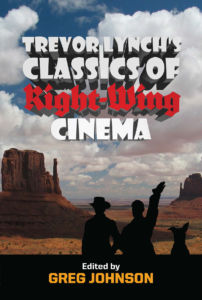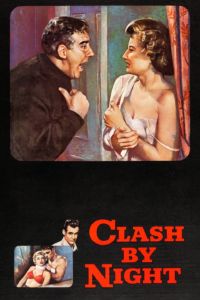Clash by Night
Since I am avoiding Oppenheimer and Barbie, I went back into the archives. While reading Arthur Miller’s The Price, I conjured YouTube and watched 1948’s All My Sons, where Edward G. Robinson and Burt Lancaster brought a tragedy by Henrik Ibsen to Middle America. I continued my sortie into post-war American cinema with Clash by Night, a 1952 Fritz Lang film based on a 1941 play by Clifford Odets. Considered a strong melodrama, it is a very watchable film dealing with emotions and relationships in post-war America in a semi-noir setting.
The film opens to reveal swirling waves washing over rocks and a beach. Mae Doyle (played by Barbara Stanwyck) returns to Monterey, California after ten years on the East Coast, a time that has left her uneasy and unsettled. Her brother Joe (Keith Andes, in his film debut) isn’t pleased to see her, but allows her to stay. His girlfriend Peggy (Marilyn Monroe) is more open, and Joe and Peggy represent a dichotomy of uneasy male control balanced by female brazenness. A stabilizing influence for Mae comes when she begins dating Jerry D’Amato (Paul Douglas), a good-natured fisherman who owns his own boat and supports his father and uncle. He’s a decent, uncomplicated guy. She isn’t quite his type, but Jerry’s affability rubs off on her. Mae seems to need something bright and stable after her years east, which was partly ruptured by an affair with a politician who died and left her a bundle, but his wife and family ultimately won the subsequent court battle.
Jerry’s brightness is contrasted by Earl Pfeffer (a moody Robert Ryan), who is a projectionist at the local movie house. The locals consider Earl to be in show business. He’s drawn to Mae, and she spars with him, but against her better judgement, she finds his cynicism enticing.
Clash by Night captures the struggle of characters tied to their community as well as the urge to break out. The fisherman’s life and the cannery recalls John Steinbeck’s Cannery Row. Mae returns with a sense of defeat and self-hatred. I was impressed by how Lang brought out the ability of characters to see faults in others, but not in themselves. Yet, a sense of rootlessness and bruised emotions suffuses the film, like those waves in the opening titles.
The title is taken from an 1851 Matthew Arnold poem, “Dover Beach”:
Ah, love, let us be true
To one another! for the world, which seems
To lie before us like a land of dreams,
So various, so beautiful, so new,
Hath really neither joy, nor love, nor light,
Nor certitude, nor peace, nor help for pain;
And we are here as on a darkling plain
Swept with confused alarms of struggle and flight,
Where ignorant armies clash by night.
Ignorance in the case of this film might be replaced by unawareness. Men don’t seem to realize their brutishness, nor women their urge to break out. Peggy, being younger, is more outspoken than Mae, but both women need men. Both subconsciously want some sort of balance.
Ignorance seems to fit Jerry. He’s always seeing the glass as half full, spending a lot of time mopping up problems caused by his father and uncle, as well as Earl’s viper-like sarcasm and attacks. One wonders what he sees in Earl, apart from the fact that they are old friends from school. Earl counters Jerry’s charity with an aggressiveness that eventually eats into Mae.
What I enjoyed most about the film is the excellent acting, the cast playing characters who are combative, yet unaware of their wants. Stanwyck’s Mae is a woman seeking a stable life, but when she finds it, she breaks down and cries. Earl is the obvious choice for her and wins her over — or wears her down; it’s not a very exultant scene — but it’s sour passion left unresolved, because in this film there is always a ghost of responsibility, especially to one’s community. The town here is an organic part of the script, full of fishermen who are tightly-knit like the sardines they catch, as are the cramped streets and the town itself, which hugs the sea. It’s not the happy suburban world of the 1950s, but a communal world is caught in post-war dislocation.

You can buy Trevor Lynch’s Classics of Right-Wing Cinema here.
The dislocating effect that the war years had on civilization is an undercurrent throughout. Mae and Earl are the most affected by it. The loosening of standards that the war brought is fully apparent. Everyone smokes and drinks too much, and they party whenever they can. There is a lack of prudery. Peggy and Joe enter a beach bar with Peggy in jeans and a bikini top and Joe is bare-chested. This recalls the world I grew up in. My father’s pre-war photos show him in a natty suit and white trousers. After his time in the Navy, he walked around the house bare-chested. Our household didn’t practice much in the way of modesty in dress nor manners. We weren’t crude, nor were my parents vulgar, but their pre-war decorum ended with Pearl Harbor.
Someone once said that the fifties was the first time in history when people began to slouch. This is an exaggeration, but there definitely was a general looseness in manners that grew and persisted. The explosive sixties weren’t so much a radical change, but the next stage in this slackening. This looseness came of an understated cynicism towards life that is best expressed in the film by Earl’s slimy and bitter remarks and actions. Clash by Night is usually characterized as a noir film, but that’s too limiting. Post-war cynicism was widespread, and despite the rosy view of the fifties many have, the “Happy Days” were always covered in shadows. A big reason was the reaction to 1940s propaganda, as Paul Fussell says in his book Wartime. The forties, with their relentless, cheery propaganda reflected in the optimistic literature produced by writers such as Thornton Wider and William Saroyan, concealed the horrors of war and a regimented society. Men who served in the military lived in a world where black was white and white black, and after the war ended — or did it? — bitterness and resentment remained with many.
Earl carries much of this with him, ostensibly due to his lousy marriage to a stripper, but his type was very common in the post-war era. For all the talk of having won a glorious victory, as shown in the Life photos, most in the military knew that the wars with Japan and Germany were about attrition and slaughter. It was a déjà vu moment for America because the Civil War had ended similarly: not in a glorious Union triumph, but only after the exhausting, bloody grinding down of Southern resistance. Added to this is what George Orwell described as the essential horror of military life. Post-war America was still a mobilized society; fighting the Communists meant a persistent wartime economy, which was in fact sustainable given the general affluence in America that was setting in at the time this film was released. It didn’t slow down until the 1970s.
In the film’s world of flotsam and drift, Mae and Earl are the main characters caught up in this, but Joe has his own troubles with Peggy. There is continual emotional turmoil between them in relation to his controlling nature and her need for some guidance. Being younger, they eventually reconcile this discontent as they learn to give and take, and Joe painfully looks past Mae’s example to see that Peggy isn’t as bitter as his sister. They realize that whatever their gripes and spats are, they need each other.
Earl is a sour friend to Jerry. His cynicism and opportunism strains Jerry but doesn’t break their friendship until the end. When Jerry finally does snap, he goes all the way in a wild, frantic protest against the corruption eating away at his stability.
I enjoy Paul Douglas as an actor. He’s not the usual gruff, savvy character here as he was in the other films I’ve seen him in. He’s hopeful and vulnerable until the end when Mae, exhausted by her emotional instability, seeks reconciliation on Jerry’s boat. He stares back, cold and brutal: the Paul Douglas I see onscreen. But maybe now, being a bit more hard-boiled and wary has made Jerry grow. He is a husband ready to demand some commitment, and will always keep an eye on Mae. It’s the final reaction of a normal man to the cynical, sleazy world around him. Don’t give up, but don’t be a glad hand.
Clash by Night is apt film for the age of Biden, as it contains an almost Christian message about coming to terms with a sleazy worldview that predominates around us. Naturally, Marilyn Monroe will be the central attraction for many; although here, she is merely a fulfilling supporting player. She created complications for the studio when she published a nude calendar, generating a lot of publicity and disruption on the set. She also had problems learning her lines, which was a Monroe trademark.
For a melodrama, Clash by Night isn’t so bad. I’ll take it over Barbie or Oppenheimer any day.
* * *
Counter-Currents has extended special privileges to those who donate $120 or more per year.
- First, donor comments will appear immediately instead of waiting in a moderation queue. (People who abuse this privilege will lose it.)
- Second, donors will have immediate access to all Counter-Currents posts. Non-donors will find that one post a day, five posts a week will be behind a “Paywall” and will be available to the general public after 30 days.
- Third, Paywall members have the ability to edit their comments.
- Fourth, Paywall members can “commission” a yearly article from Counter-Currents. Just send a question that you’d like to have discussed to [email protected]. (Obviously, the topics must be suitable to Counter-Currents and its broader project, as well as the interests and expertise of our writers.)
To get full access to all content behind the paywall, sign up here:
Paywall Gift Subscriptions
 If you are already behind the paywall and want to share the benefits, Counter-Currents also offers paywall gift subscriptions. We need just five things from you:
If you are already behind the paywall and want to share the benefits, Counter-Currents also offers paywall gift subscriptions. We need just five things from you:
- your payment
- the recipient’s name
- the recipient’s email address
- your name
- your email address
To register, just fill out this form and we will walk you through the payment and registration process. There are a number of different payment options.




